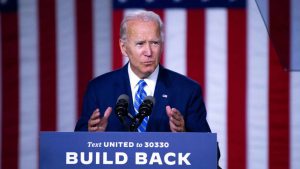JULY 16, 2020

Joe Biden speaking in Wilmington, Del., this week. – Kriston Jae Bethel/NY Times
With Joe Biden claiming almost a double-digit lead in national polls, one question still seems to loom over the race: Can we trust the polls after 2016?
It’s a good question. But for now, it’s not as important as you might guess. If the election were held today, Mr. Biden would win the presidency, even if the polls were exactly as wrong as they were four years ago.
The reason is simple: His lead is far wider than Hillary Clinton’s was in the final polls, and large enough to withstand another 2016 polling meltdown.
This is not to say that President Trump can’t win. There are still nearly four months to go until the election — more than enough time for the race and the polls to change. The race changed on several occasions over the final months in 2016. And this race has already changed significantly in the last four months. According to FiveThirtyEight, three months ago Mr. Biden held a lead of only about four points.
And while Mr. Biden can currently survive a 2016-like polling error, there is no reason a polling error couldn’t be even larger in 2020.
But for now, his lead is large enough to survive a 2016 repeat and just about every general-election polling error in recent memory. He leads by an average of nearly 10 percentage points in national polls since June 1, well ahead of Mrs. Clinton’s four-point lead in the final national polls or her peaks of about seven points in early August and mid-October.
Mr. Biden also enjoys a far wider lead in the battleground states likeliest to decide the presidency. His 13-point lead in a Monmouth University poll of Pennsylvania published on Wednesday, for instance, puts him in a much stronger position than Mrs. Clinton, who had a four-point lead in the last Monmouth poll of Pennsylvania taken just before the election.
Of course, the polls could be even further off this time than four years ago. But there are also many reasons to think they could be better this time around.
Perhaps most important, many pollsters now weight their sample to properly represent voters without a college degree. The failure of many state pollsters to do so in 2016 is widely considered one of the major reasons the polls underestimated Mr. Trump’s support. Voters without a four-year college degree are far less likely to respond to telephone surveys — and far likelier to support Mr. Trump. By our estimates, weighting by education might move the typical poll by as much as four points in Mr. Trump’s direction.
Though many state pollsters still do not weight by education, far more do than four years ago. The Monmouth poll is one example. The final Monmouth poll of Pennsylvania in 2016, which showed Mrs. Clinton up four percentage points, would have shown her with a two-point lead, 47 percent to 45 percent, if it had been weighted by education, according to Patrick Murray, director of the poll. That alone covers about half of the difference between the actual result and the final Monmouth poll, and it’s a reason to have more confidence in the new Monmouth poll.
Education weighting is not enough to ensure a perfect result. After all, Mrs. Clinton still would have led — albeit quite narrowly — in the final Monmouth poll of Pennsylvania, even weighted by education. And other high-quality, education-weighted state polls, like the Marquette Law School poll in Wisconsin, still showed Mrs. Clinton with a considerable edge in 2016. Other factors were clearly at play.
But many of the other sources of polling error in 2016 also seem less likely to repeat.
There are far fewer undecided or minor-party voters now than four years ago. These voters broke in Mr. Trump’s favor, according to exit polls and postelection surveys that recontacted pre-election respondents, helping to explain part of his strength in the final results. Undecided voters could again break toward Mr. Trump, but this time there are simply fewer of them — and therefore less opportunity for the polls to be wrong for that reason.
Another component of the polling error in 2016 was turnout. It is hard to generalize the role of turnout in the polling misfire because there are as many likely-voter models as there are pollsters. But some pollsters probably overestimated Black turnout by relying too heavily on Obama-era turnout models. This time, reliance on the last election could just as easily understate Democratic turnout. In general, the party out of power tends to enjoy relatively higher turnout than when it’s in power, and that could help Democrats compared with 2016.
In the case of the Monmouth poll, it turns out that turnout was a significant factor. Mr. Trump would have led Mrs. Clinton by one percentage point, 45 percent to 44 percent, in the final Monmouth University poll of Pennsylvania if it had been weighted by education and if the likely-voter sample had consisted only of those who ultimately voted, according to voter file records. (Mr. Trump won the state by 0.7 of a point.)
Similarly, the final New York Times/Siena College poll of North Carolina, which was conducted over the weekend before the election and found the candidates tied, would have shown Mr. Trump ahead by four percentage points (he won by 3.6 points) if the likely-voter sample had consisted only of validated voters. These kinds of findings led many pollsters to conclude that survey research wasn’t fundamentally broken after the 2016 election, and led many to redouble their efforts rather than abandon the enterprise.
Of course, addressing the last election’s polling problems doesn’t ensure that there won’t be another type of polling failure.
Perhaps the biggest risk is one that has loomed over the polling industry for a decade: declining response rates to telephone surveys. Up until now, there has been little evidence that low response rates have endangered the accuracy of high-quality survey research. It turns out that the people who respond to telephone surveys appear to vote similarly to people from their same demographic group who do not respond.
But they are different in some ways. They are likelier to be volunteers. They are likelier to express trust in their neighbors and society. Such differences could become more significant, or grow into closer alignment with political views. In the worst-case scenario, declining trust in experts, the news media and polling could lead to systematic nonresponse bias, where even adjusting for education or demographics would be far from enough to ensure a representative sample.
There are reasons to doubt that this will happen. Only a few months ago, polls showed Mr. Trump highly competitive, and there is a fairly simple explanation for the turn against him: his handling of coronavirus. The trend against the president holds regardless of how the survey was conducted. Panel surveys, in which respondents are repeatedly contacted, also show former Trump supporters abandoning the president. And most surveys show the right number of respondents who say they voted for Mr. Trump in 2016. They’re just saying they won’t vote for him again. It would take an awfully targeted form of bias for polls to get the right number of 2016 Trump voters yet vastly overrepresent those who are leaving him.
Even so, you can imagine how it could, possibly, happen — such problems can’t be discounted. The problems even harder to discount are those that can’t be imagined.
Courtesy/Source: NY Times






































































































